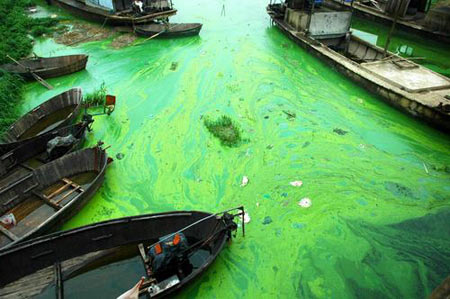People living around Lake Chao Hu use the lake’s resources to provide an income. Not only does the current ecological situation restrict fishermen from making a living, it also negatively affects tourism.
 |
| Source: <http://www.chinadaily.com.cn/china/2009-07/09/content_8404343_3.htm> |
 |
| Source: <http://english.anhuinews.com/system/2010/05/28/003017037.shtml> |
In 2008, the government responded to people’s concerns by lowering the amount of industrial waste they discharged into the lake by 70% when compared to the amount of waste in 2005 (“Chao Hu Lake faces imminent algae outbreak”). This is a good step, since urban sewage, one of the biggest contributors of excess nutrients into the lake, was causing eutrophication and making the water unsuitable for drinking. Also, China Daily reports that algae-eating fish were released into the lake. If the fish can eat faster than the algae blooms and destroys their oxygen source, they can succeed in diminishing algae populations. However, this might be more of a temporary solution. Essentially, the lake will not fully recover or be able to maintain a healthy state unless it is protected against urban runoff.
While the government is taking steps to stop eutrophication, it needs to ensure that this does not occur again in the future. Despite their current efforts, algal blooms affect the lake during the summer. It is necessary to protect the lake because it is the livelihood of many people. Therefore, long term solutions should also be considered. In addition to present efforts, the government should place stricter regulations on industry, find an eco-friendly alternative to fertilizers, and invest in infrastructure that can support the larger population sizes. Furthermore, a set of quality standards similar to the Clean Water Act in the United States should be used to keep the lake in good condition. With enough planning, the cities around Lake Chao Hu will be able to use the lake's resources and enjoy a growing economy while ensuring that the lake is fishable, drinkable, and swimmable.

.jpg)



